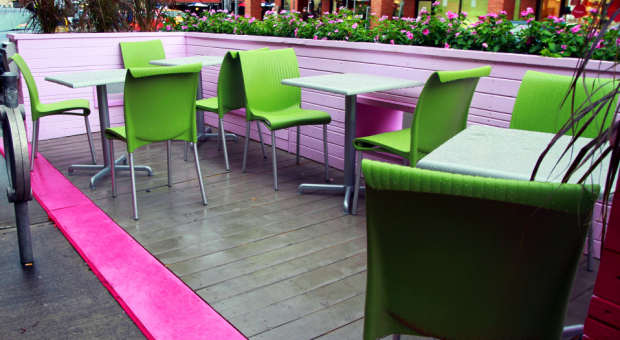Reviews are mixed for the bright pink parklets that lined the east side of Church Street this summer, and some local business owners are questioning whether to repeat the program in 2014.
At the Church Wellesley Village Business Improvement Area (BIA) annual general meeting Nov 4, BIA manager David Wootton said some businesses on the west side of the street feel they missed out, but he says the price tag to implement the program on both sides of the street, at $250,000, is just too high.
Budget-wise, Wootton says, the BIA was able to do it this year only because Councillor Kristyn Wong-Tam’s office took care of almost all the costs. “As of now, we won’t see them in 2014 unless a corporate sponsor coughs up the money,” he says.
However, Wootton says the BIA is not actively looking for sponsors at the moment.
Wong-Tam says that putting parklets on both sides of the street is not realistic. “From a parking perspective, there are no restrictions in removing parking spots on the east side of the street,” she says.
To install them on the west side, a traffic study would be required, which would cost $10,000 to $15,000, she says.
Avery Pitcher, co-chair of the BIA, said some businesses, especially the bars and restaurants on the west side of the street, feel they missed out on patio business. “The other side of the street asks why the parklets aren’t on their side.”
Wong-Tam has also heard criticism from businesses. “I understand Pride takes the street for the first part of the summer. So you lose some of the patio season,” she said, noting that the parklets can’t be installed on the street during Pride.
“This summer was a pilot project. It was like concierge service. Everything was done for you,” Wong-Tam told the AGM.
The parklets, which sat on Church Street for four months, were part of a pilot project modelled after 2012’s Celebrate Yonge event.
From start to finish, all expenses were taken care of, she says. The patios were built and installed, then, near the end of October, they were taken down and put into storage, all paid for by the city and corporate partners.
Home Depot donated $20,000 in building materials, and the Carpenters Union Local 27 donated the human resources to build the parklets. The city is paying the cost of storage through the winter.
If the BIA decides to keep the parklets going, businesses will have to pick up the tab. “For the first time around, [the city] wanted to demonstrate to the community what the parklets could be like,” Wong-Tam says. “But, going forward, you are going to have to want it, champion it and pay for it.”
The BIA now owns the parklets, she says. “You are not starting from ground zero. You have an incredible infrastructure investment to work from.”
Still, BIA co-chair Liz Devine, from Rainbow High Travel, says response to the parklets has been mixed.
“The residents enjoy the space, and the businesses like the extra seating,” she says. “[But] we’re a small destination to do the parklet program.”
Rupert Hon, BIA treasurer and TD Canada Trust branch manager, notes that $250,000 to put parklets on both sides of the street is a lot of money. The approximate cost to repeat the parklets on just the east side is $50,000 to $100,000, he says.
The cost includes materials to assemble the parklets, labour to install and dismantle them, landscaping and storage. Hon says storage alone costs between $6,000 and $10,000.
Before next year, Hon says, the BIA will consult with the community, both businesses and residents, to gauge whether there’s interest in pursuing a corporate sponsor. That would likely mean corporate logos and branding on the parklets, he says.
Hon says the businesses were expected to keep the patios clean, but that didn’t really happen, so the BIA also had to pay for cleaning.
“They were supposed to be maintaining them,” he says. “I don’t know if you noticed, but many of them have not been maintained the way they should have. I’ll be honest with you; we ended up footing some of the costs for that as well. There were cleaning costs, and the BIA paid for that.”
Hon questions whether the parklets are the best way to bring business to the Village. “The original idea was to animate the street, make the street more lively and beautiful,” he says. “But from a business perspective, did they really add any value? Have they resulted in an increase in business?”
Not all the parklets were licensed because Wong-Tam requested that some should be designated public space, usable by anyone. But, Hon says, business owners told him, ‘If they can’t be licensed, what’s the point in having a parklet right in front of my business?’
“The BIA is here to promote business,” he says. “We want to promote people coming here to shop, play and spend money,” he says. “So we don’t want to take on any projects that discourage business. Now, I understand the residents have a different opinion.”
Resident Chris Drew, a member of the Church Wellesley Neighbourhood Association, loves the parklets and wants the BIA to keep the program going. He says residents want to help the BIA do whatever it takes to make sure the project happens again next year.
“We thought the parklets were a great first step,” he says. “We’d like to see it back next year in some way, shape or form. We’d actually love to see it expanded further up and down the street.”

 Why you can trust Xtra
Why you can trust Xtra


